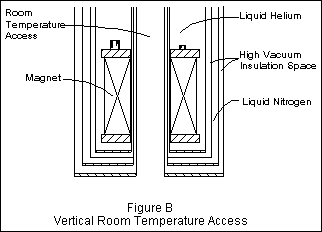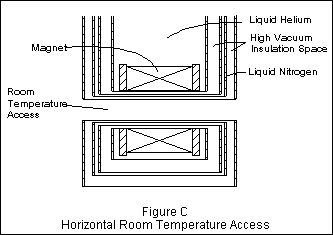
Room Temperature Access Systems
If experiments are to be performed at room temperature, room temperature access systems
can be provided. The room temperature bore tube is surrounded by one or two radiation
shield bore tubes, which are thermally tied to the liquid nitrogen shield. The liquid
helium bore tube surrounds the radiation shield tubes and the cold bore of the magnet
surrounds the entire room temperature bore assembly. Room temperature access can be
provided in either the
vertical position
illustrated in Figure B or the
horizontal position
shown in Figure C. Horizontal room temperature access systems are frequently enclosed
in the dewar by welding and are not readily accessible after assembly.

Variable Temperature Access Systems
Frequently experiments must be performed over a wide range of temperatures. By pumping
on the helium bath the temperature can be lowered from the normal boiling point of
liquid helium (4.2K) to the lambda point (2.17K) where superfluidity occurs. Because
a substantial amount of helium is consumed in reducing the temperature of the magnet,
it is generally more practical to insert a second liquid helium dewar into the bore
of the magnet so the temperature of the sample can be reduced without cooling the
magnet unnecessarily.
A
insert dewar
of this type can be used for experiments in the temperature range from 2K to 5K by
filling with liquid helium and pumping or pressurizing as required, or operate at
77K by inserting liquid nitrogen. Experiments at room temperature can also be
performed with a insert dewar.
Where continuous variation of the temperature is required, a
variable temperature insert
is used. Cooling is achieved by withdrawing a controlled amount of liquid helium
from the reservoir through a valved capillary tube. The helium is fed into the
bottom of the sample tube, flows over the sample and is extracted at the top of
the dewar. By heating the helium with the electrical heater on the bottom of the
sample tube, the temperature of the sample can be varied. This arrangement can be
used to achieve temperatures from 1.5K to 300K and can be used with a separate
temperature controller to regulate the temperature of the cryostat.
Each of the options mentioned above requires that the bore of the magnet be enlarged
to provide room for the extra vacuum jacket required to isolate the sample from the
liquid helium.
Most experiments are performed with the sample mounted parallel to the magnetic field.
However, experiments requiring that the sample be transverse to the magnetic field
can be performed in two ways. First, the sample can be mounted in a solenoid with the
sample transverse to the field; or second, the magnet can be constructed so access is
provided in a radial direction through the midplane of the magnet. Variable
temperature insert dewars can also be provided for this magnet configuration.
Optical Access Systems
Optical access
to the sample can be provided either along the axis of the magnet or through its
midplane. When the optical path is parallel to the field, windows can be provided
in the bottom of the dewar and light can be passed along the vertical axis. If
optical access is required both along the axis and transverse to it, a split coil
configuration is used. The magnet can be mounted with the magnetic axis either
horizontal or vertical.
If the magnetic axis is vertical, four or more optical ports can be provided in
the horizontal plane, each providing a view transverse to the magnetic field, and
an additional window can be mounted in the bottom to permit light to be transmitted
along the axis. If the magnetic axis is horizontal, four ports can be provided in
the horizontal plane to provide two optical paths; one parallel to and one
transverse to the magnetic axis.
If helium can be tolerated in the light path, windows are placed on the outside of
the helium reservoir and on the outer jacket of the dewar. The magnet can be simply
inserted into the dewar. Where the light path must be evacuated, the magnet is
constructed on a bobbin that is vacuum tight, and the magnet is welded into the
dewar and becomes an integral part of it. Windows are then placed only on the room
temperature outer jacket; or optionally on the radiation shield of the dewar,
unless temperature control of the sample is required.
Temperatures can be varied in optical dewars by placing the samples in a separate
variable temperature insert having optical windows. The temperature is varied by
vaporizing and heating helium as discussed earlier.
Once the configuration and temperature variation requirements for your experiments
are specified, the size of your samples should be considered carefully. The minimum
size sample that can be used without compromising the results of your present or
future experiments should be ascertained. This factor ultimately affects the size
and cost of the magnet and dewar in your system.

 Level Instrumentation
Level Instrumentation
 Magnet Power Supplies
Magnet Power Supplies
 Cryogenic Components
Cryogenic Components
 Dewars
Auto-Fill Systems
Current Leads
Dewars
Auto-Fill Systems
Current Leads
 Low Temperature Inserts
Warranty
Contract Manufacturing
Image Gallery
Low Temperature Inserts
Warranty
Contract Manufacturing
Image Gallery

